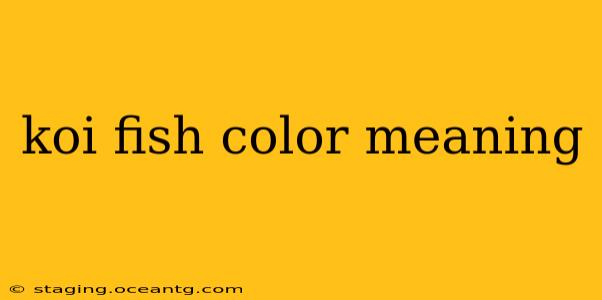Koi fish, with their vibrant colors and graceful movements, have captivated people for centuries. More than just beautiful aquarium inhabitants, these fish hold deep symbolic meaning in Japanese culture and beyond. Understanding the specific meaning associated with each koi color can unlock a deeper appreciation for these elegant creatures. This guide delves into the rich symbolism of koi fish colors, exploring their significance in art, tradition, and modern interpretations.
What do the different colors of Koi fish symbolize?
This is a frequently asked question, and the answer is nuanced. Each color, and sometimes even the patterns, carries its own unique weight of symbolism. Let's explore the most common koi colors and their meanings:
Black Koi (Kuro):
Black koi, often referred to as Kuro, represent overcoming challenges and difficulties. They symbolize perseverance, strength, and the ability to conquer adversity. Their dark hue signifies wisdom, maturity, and a profound understanding of the complexities of life. In some interpretations, they represent masculinity and independence.
Red Koi (Hi):
Red koi, known as Hi, are powerful symbols of love, passion, courage, and vitality. The intense red color is associated with strong emotions and the energy of life itself. They are often seen as representing good fortune, prosperity, and a life filled with joy.
White Koi (Shiro):
White koi, or Shiro, embody purity, innocence, and spiritual awareness. Their pristine color symbolizes peace, tranquility, and a connection to a higher power. They often represent a clean slate, new beginnings, and the pursuit of enlightenment.
Yellow Koi (Ki):
Yellow koi, Ki, represent wealth, prosperity, and good fortune. The bright, sunny color is associated with optimism, happiness, and a positive outlook on life. They symbolize abundance, success, and the achievement of one's goals.
Blue Koi (Ai):
Blue koi, Ai, are less common but hold significant meaning. They symbolize tranquility, peace, and calmness. Their serene color is associated with serenity, quiet strength, and a harmonious connection with nature.
Orange Koi (Aka):
Similar to red koi, orange koi (Aka) symbolize passion and vitality, but often with a softer, more approachable energy. They represent ambition and the drive to succeed while retaining a balance and groundedness.
Multi-colored Koi (Bekko, etc.):
Many koi are multi-colored, showcasing a blend of the above meanings. The specific combination of colors influences the overall symbolism. For example, a Bekko koi, with its tortoise-shell pattern, combines the strength of black with the passion of red, adding a layer of resilience and stability to the overall meaning.
What are some other common questions about Koi fish symbolism?
Let's address some other frequently asked questions surrounding koi fish meaning:
Do Koi fish patterns affect their symbolism?
Yes, absolutely! The patterns on koi fish, such as the Kujaku (peacock) or Tancho (single red spot on a white body), add further layers to their symbolic meaning. These patterns often represent specific traits or characteristics, enhancing the overall message.
What does a single koi fish symbolize?
A single koi can still carry powerful symbolism, depending on its color. It often represents a specific quality or characteristic associated with that particular color.
How is Koi fish symbolism used in art and design?
Koi fish are frequently depicted in Japanese art, particularly in paintings and tattoos. Their vibrant colors and symbolic meanings make them a popular subject, conveying messages of strength, perseverance, and good fortune.
What is the significance of Koi fish in Feng Shui?
In Feng Shui, koi fish are believed to attract wealth, prosperity, and good luck. They are often incorporated into home décor to create a harmonious and positive environment.
Conclusion: The Enduring Allure of Koi Fish Symbolism
The symbolism of koi fish is rich, layered, and deeply embedded in Japanese culture. Their vibrant colors and graceful forms serve as powerful visual representations of various positive attributes, making them a popular subject of art, contemplation, and even good fortune. Understanding the specific meaning behind each color and pattern allows for a deeper appreciation of these remarkable creatures and their enduring cultural significance.
